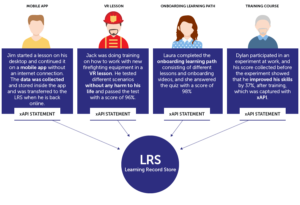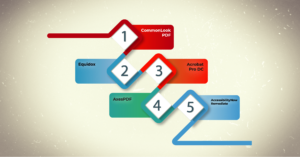I got really interested in xAPI when a client needed my help analyzing their e-learning course, which was created using SL360 by me. I was curious and excited about the possibilities of xAPI, so I decided to dive deeper and learn more about it. Currently, I’m doing some research to fully understand xAPI, data visualization, and integration.
In this article, you will learn about xAPI, the standard for tracking and sharing learning experiences. xAPI, also known as Experience API( xAPI), allows for the tracking, storing, and sharing of learning experiences across different platforms and contexts. Developed by the US Department of Defense-funded Advanced Distributed Learning (ADL) in collaboration with Rustici Software and SCORM users, xAPI provides a better understanding of user learning both online and offline.
By capturing data in a Learning Record Store (LRS), xAPI enables improved data capture, integration of data from multiple sources, easy data transfer, and the ability to connect learning and performance. With xAPI, you can enhance talent management and development, gain insights into customer interactions, ensure data security, and improve learning assets through analytics.
To provide more context about xAPI, it’s important to note that there are several specifications used to measure the effectiveness of an eLearning environment. These include SCORM, AICC, and Experience API (xAPI). Among these, xAPI is the newest and is considered to be the industry standard. As we explore xAPI in more detail, we will also compare it to the other two specifications, SCORM and AICC.
![]()
Introduction to xAPI: The Standard for Tracking and Sharing Learning Experiences
xAPI, also known as the Experience API or Tin Can API, is a standard that revolutionizes the way we track, store, and share learning experiences across platforms and contexts. Developed by the US Department of Defense-funded Advanced Distributed Learning (ADL) in collaboration with Rustici Software and SCORM users, xAPI allows for a better understanding of user learning both online and offline.
Definition of xAPI
xAPI is an application programming interface (API) specification that enables the collection and exchange of data about people’s learning experiences. It provides a standardized format for capturing and sharing learning activities, enabling organizations to track and analyze learning outcomes in a more granular and comprehensive manner.
Development of xAPI
The need for a more flexible and comprehensive learning tracking system led to the development of xAPI. SCORM (Sharable Content Object Reference Model) and AICC (Aviation Industry Computer-Based Training Committee) were the previous standards used to track eLearning activities. However, they had limitations in terms of capturing data from non-traditional learning experiences.
To address these limitations, the ADL initiated the development of xAPI in 2011, with the goal of creating a specification that could track learning experiences beyond the confines of a traditional learning management system (LMS). The collaboration between the ADL, Rustici Software, and SCORM users resulted in the creation of xAPI, which was officially released in 2013.
Benefits of xAPI
One of the key benefits of xAPI is its ability to capture a wider range of learning experiences. Traditional eLearning activities, such as completing a course or passing a quiz, can be easily tracked with xAPI. However, xAPI goes beyond that and allows for the tracking of informal learning experiences, such as reading a blog post, watching a video, or participating in a discussion forum.
Another benefit of xAPI is its integration capability. It allows data from multiple sources, such as eLearning platforms, mobile apps, simulations, and even physical activities, to be collected and stored in a central location. This integration of data enables organizations to have a holistic view of an individual’s learning experiences.
Furthermore, xAPI simplifies data transfer between systems. Instead of relying on complex integrations or custom code, xAPI provides a standardized format for data exchange. This makes it easier to share learning data between different systems, such as an LMS and a learning analytics tool.
Finally, xAPI enables the connection between learning and performance. By tracking learning experiences and correlating them with performance data, organizations can gain valuable insights into the effectiveness of their training programs and identify areas for improvement.
How xAPI Works
To understand how xAPI works, let’s walk through the process of capturing, sending, storing, and interpreting learning statements.
Capturing statements from learning activities
The first step in the xAPI process is capturing statements from learning activities. These statements, also known as “xAPI statements” or “activity statements,” describe the learning experience in a structured format. Each statement consists of three elements: the actor, the verb, and the object.
The actor represents the person or entity performing the learning activity, such as a learner or an instructor. The verb indicates the action performed, such as “completed,” “watched,” or “answered.” The object refers to the target or focus of the action, such as a course, a video, or a quiz. Together, these elements provide a clear and concise description of the learning experience.
Sending statements to the LRS
Once the statements are captured, they are sent to a Learning Record Store (LRS). The LRS serves as the central repository for all learning statements and associated data. It is responsible for storing the statements, performing data analysis, and providing access to the stored data.
The LRS can be located either on-premises or in the cloud, depending on the organization’s preferences and requirements. xAPI provides a set of APIs that enable the communication between learning systems and the LRS, allowing for the seamless transfer of data.
Storage and interpretation in the LRS
In the LRS, the statements are stored in a standardized format known as the Experience Data Model (XDM). The XDM provides a common structure for organizing and interpreting learning data. It ensures consistency in how various systems process and analyze the data captured by xAPI.
The LRS also supports advanced analytics and reporting capabilities. By analyzing the learning statements, organizations can gain insights into learner behavior, identify trends and patterns, and measure the effectiveness of their training programs. These insights can then be used to improve the design and delivery of future learning experiences.
![]()
Key Terminologies
To fully grasp the concepts and functionalities of xAPI, it’s important to familiarize yourself with some key terminologies associated with the standard. Let’s explore these terminologies in more detail.
Learning activities
Learning activities refer to any experience or interaction that contributes to a person’s learning journey. Examples of learning activities include completing a course, watching a tutorial video, participating in a discussion forum, or attending a webinar. xAPI allows for the tracking of these activities, regardless of the platform or context in which they occur.
Providers
Providers, also known as learning systems or platforms, are the sources of learning activities. They can be traditional learning management systems (LMS), eLearning platforms, mobile apps, virtual reality (VR) environments, or even physical devices. xAPI enables these providers to track and record learner interactions, using a common format that can be understood and processed by the LRS.
Statements
Statements are the core building blocks of xAPI. They describe the learning activities performed by individuals or groups. Each statement consists of an actor, a verb, and an object, as mentioned earlier. For example, a statement could be “John completed the course ‘Introduction to Programming’.” Statements can also include additional contextual data, such as timestamps, locations, or scores.
Want to learn additional Terminologies, CLICK HERE
Learning Record Store (LRS)
The Learning Record Store (LRS) is the central repository where xAPI statements are stored and managed. It serves as a secure and scalable data storage solution, capable of handling large volumes of learning data. The LRS also provides APIs for data retrieval and analysis, allowing organizations to gain insights into learner behavior and measure the effectiveness of their training programs.
Comparison with SCORM, AICC, and xAPI
To further understand the significance of xAPI, it is important to compare it with the previous standards used for tracking eLearning activities: SCORM and AICC.
Overview of SCORM
SCORM, which stands for Sharable Content Object Reference Model, is a set of technical standards used for tracking and managing eLearning content. It was developed in the late 1990s and quickly became the de facto standard for eLearning interoperability. SCORM provides a common format for packaging eLearning content and tracking learner interactions.
However, SCORM has some limitations. It primarily focuses on tracking activities within a single learning management system (LMS) and does not support tracking of offline or informal learning experiences. SCORM also relies on JavaScript for communication between the eLearning content and the LMS, which can result in compatibility issues.
Overview of AICC
AICC, short for Aviation Industry Computer-Based Training Committee, is another eLearning specification that predates SCORM. It was initially developed in the aviation industry to track pilot training activities. AICC provides a standard communication interface between eLearning courses and the LMS.
Like SCORM, AICC has limitations in terms of tracking offline and informal learning experiences. It also relies on JavaScript for communication, which can lead to compatibility issues. Additionally, AICC is less flexible and extensible compared to SCORM.
Differences between xAPI and SCORM/AICC
The main difference between xAPI and SCORM/AICC lies in their focus and capabilities. Unlike SCORM and AICC, which are primarily designed for tracking activities within a single LMS, xAPI allows for the tracking of learning experiences across platforms and contexts.
xAPI also goes beyond tracking traditional eLearning activities and includes support for offline and informal learning experiences. It provides a more granular level of tracking, capturing not only course completions and quiz scores but also interactions with videos, simulations, websites, and physical activities.
Moreover, xAPI eliminates the reliance on JavaScript for communication, making it more flexible and compatible with a wide range of technology platforms. It provides a standardized format for data exchange, simplifying integrations between different systems.
![]()
Examples of xAPI in Action
xAPI has found numerous applications in various industries, demonstrating its versatility and effectiveness in tracking and analyzing learning experiences. Let’s explore some examples of xAPI in action.
Use with virtual reality (VR) for training
Virtual reality (VR) has gained significant popularity in recent years as a powerful tool for immersive and interactive training experiences. xAPI can enhance the effectiveness of VR training by capturing and analyzing learner interactions within the virtual environment.
For example, imagine a scenario where employees undergo safety training using a VR simulation. xAPI can track their movements, actions, and decisions within the simulation, providing valuable data on their performance and learning outcomes. This data can then be used to identify areas for improvement, personalize future training experiences, and measure the effectiveness of the VR training program.
Other real-world applications of xAPI
Apart from VR training, xAPI has been successfully implemented in various other real-world applications. For instance, in the healthcare industry, xAPI can track and analyze the learning experiences of medical professionals, ensuring that they stay up-to-date with the latest medical knowledge and procedures.
In the corporate world, xAPI can be used to track employee onboarding and training activities, capturing data on their progress, engagement, and proficiency. This data can help organizations optimize their training programs, identify skill gaps, and measure the impact of learning on employee performance.
Importance of xAPI in Talent Management and Development
xAPI plays a crucial role in talent management and development by providing valuable insights into user learning and connecting learning to performance. Let’s explore these aspects in more detail.
Insights into user learning
xAPI enables organizations to gain deep insights into user learning by capturing and analyzing a wide range of learning experiences. By tracking not only traditional eLearning activities but also informal and experiential learning, xAPI provides a comprehensive view of an individual’s skills, knowledge, and competencies.
This comprehensive view allows organizations to identify learning patterns, individual strengths and weaknesses, and potential areas for improvement. It enables personalized learning experiences, tailored to the specific needs and preferences of each learner. With xAPI, organizations can make data-driven decisions about their training programs, ensuring that they are effective, engaging, and aligned with organizational goals.
Connecting learning and performance
One of the key advantages of xAPI is its ability to connect learning to performance. By tracking and correlating learning experiences with performance data, organizations can measure the impact of learning on employee productivity, efficiency, and job satisfaction.
For example, if an organization implements a sales training program, xAPI can track the learning activities of the sales team and analyze the impact of the training on their sales performance. This data can help identify areas where the training was effective and areas where additional support may be needed. It enables organizations to continuously improve their training programs and ensure that they are directly contributing to improved performance and business outcomes.
Improving learning assets through analytics
xAPI’s data collection and analytics capabilities enable organizations to improve their learning assets, such as courses, videos, simulations, and assessments. By analyzing learner interactions, organizations can identify areas where learners struggle, where they excel, and where they lose interest.
These insights can be used to make data-driven improvements to learning assets. For example, if learners consistently struggle with a particular concept or activity, adjustments can be made to the content, delivery method, or assessment to provide better support and increase learning effectiveness.
![]()
Data Security in xAPI
When dealing with any form of data collection and storage, data security should always be a top priority. xAPI incorporates several measures to ensure the security and privacy of the stored learning data.
Ensuring data security in xAPI
xAPI provides mechanisms for securing the transfer of data between systems. It supports secure communication protocols, such as HTTPS, to ensure the confidentiality and integrity of the data in transit. This encryption ensures that sensitive information, such as personal identifiers or assessment scores, is protected from unauthorized access.
Administrative controls are also in place to manage access and permissions to the data stored in the LRS. Organizations can define roles and access levels for different users, ensuring that only authorized individuals have access to the data. This helps maintain data integrity and prevent unauthorized modifications or deletions.
Additionally, organizations have the flexibility to choose between on-premises or cloud-based LRS solutions, based on their specific security requirements and preferences. Cloud-based LRS solutions often have built-in security measures, including data encryption and regular security updates, increasing the overall security of the learning data.
Privacy considerations with xAPI
In addition to ensuring data security, organizations must also consider privacy considerations when implementing xAPI. The data collected by xAPI may contain personal information, such as learner names or email addresses. Organizations need to handle this data responsibly and in compliance with applicable privacy regulations, such as the General Data Protection Regulation (GDPR).
xAPI provides options for anonymizing or pseudonymizing the data, in order to protect the privacy of individual learners. Organizations can use unique identifiers instead of personal identifiers in the xAPI statements, ensuring that the data cannot be directly linked to an individual. This allows organizations to analyze and aggregate learning data without compromising the privacy of their learners.
Want to learn more, CLICK HERE
Conclusion
xAPI is a powerful standard that revolutionizes the way we track, store, and share learning experiences. Developed by the ADL, in collaboration with Rustici Software and SCORM users, xAPI allows for a better understanding of user learning both online and offline. Its benefits, including improved data capture, integration of data from multiple sources, easy data transfer, and the ability to connect learning and performance, make it an essential tool for talent management and development.
By capturing statements from learning activities, sending them to the LRS for storage and interpretation, and utilizing key terminologies such as learning activities, providers, statements, and the LRS, organizations can gain valuable insights into user learning and improve their training programs. xAPI’s data security measures ensure the confidentiality and integrity of learning data, while privacy considerations protect the rights and privacy of individual learners.
With its versatility, xAPI has found applications in various industries, including the use of VR for training and improving real-world learning experiences. By embracing xAPI, organizations can make data-driven decisions, optimize their training programs, and connect learning to performance, ultimately driving improved learning outcomes and business success.
![]()




